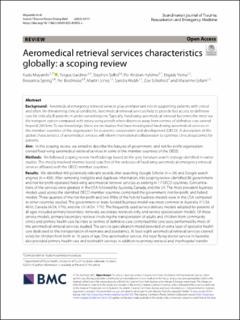| dc.contributor.author | Muyambi, Kuda | |
| dc.contributor.author | Gardiner, Fergus | |
| dc.contributor.author | Sollid, Stephen J. M. | |
| dc.contributor.author | Hyldmo, Per Kristian | |
| dc.contributor.author | Yisma, Engida | |
| dc.contributor.author | Spring, Breeanna | |
| dc.contributor.author | Bredmose, Per Poelhøi | |
| dc.contributor.author | Jones, Martin | |
| dc.contributor.author | Walsh, Sandra | |
| dc.contributor.author | Schofield, Zoe | |
| dc.contributor.author | Gillam, Marianne | |
| dc.date.accessioned | 2023-02-17T15:08:56Z | |
| dc.date.available | 2023-02-17T15:08:56Z | |
| dc.date.created | 2022-12-13T09:56:27Z | |
| dc.date.issued | 2022 | |
| dc.identifier.citation | Muyambi, K., Gardiner, F., Sollid, S., Hyldmo, P. K., Yisma, E., Spring, B., ... & Gillam, M. (2022). Aeromedical retrieval services characteristics globally: a scoping review. Scandinavian journal of trauma, resuscitation and emergency medicine, 30(1), 1-11. | en_US |
| dc.identifier.issn | 1757-7241 | |
| dc.identifier.uri | https://hdl.handle.net/11250/3052088 | |
| dc.description.abstract | Background
Aeromedical emergency retrieval services play an important role in supporting patients with critical and often life-threatening clinical conditions. Aeromedical retrieval services help to provide fast access to definitive care for critically ill patients in under-served regions. Typically, fixed-wing aeromedical retrieval becomes the most viable transport option compared with rotary-wing aircraft when distances away from centres of definitive care extend beyond 200 kms. To our knowledge, there are no studies that have investigated fixed-wing aeromedical services in the member countries of the organisation for economic cooperation and development (OECD). A description of the global characteristics of aeromedical services will inform international collaboration to optimise clinical outcomes for patients.
Aim
In this scoping review, we aimed to describe the features of government- and not-for-profit organisation-owned fixed-wing aeromedical retrieval services in some of the member countries of the OECD.
Methods
We followed scoping review methodology based on the grey literature search strategy identified in earlier studies. This mostly involved internet-based searches of the websites of fixed-wing aeromedical emergency retrieval services affiliated with the OECD member countries.
Results
We identified 460 potentially relevant records after searching Google Scholar (n = 24) and Google search engines (n = 436). After removing ineligible and duplicate information, this scoping review identified 86 government-and not-for-profit-operated fixed-wing aeromedical retrieval services as existing in 17 OECD countries. Concentrations of the services were greatest in the USA followed by Australia, Canada, and the UK. The most prevalent business models used across the identified OECD member countries comprised the government, not-for-profit, and hybrid models. Three-quarters of the not-for-profit and two-fifths of the hybrid business models were in the USA compared to other countries studied. The government or state-funded business model was most common in Australia (11/24, 46%), Canada (4/24, 17%), and the UK (4/24, 17%). The frequently used service delivery models adopted for patients of all ages included primary/secondary retrievals, secondary retrievals only, and service specialisation models. Of these service models, primary/secondary retrieval involving the transportation of adults and children from community clinics and primary health care facilities to centres of definitive care comprised the core tasks performed by most of the aeromedical retrieval services studied. The service specialisation model provided an extra layer of specialist health care dedicated to the transportation of neonates and paediatrics. At least eight aeromedical retrieval services catered solely for children from birth to 16 years of age. One aeromedical service, the royal flying doctor service in Australia also provided primary health care and telehealth services in addition to primary retrieval and interhospital transfer of patients. The doctor and registered nurse/paramedic (Franco-German model) and the nurse and/or paramedic (Anglo-American model) configurations were the most common staffing models used across the aeromedical services studied.
Conclusions
The development and composition of fixed-wing aeromedical emergency retrieval services operated by not-for-profit organisations and governments in the OECD countries showed diversity in terms of governance arrangements, services provided, and staffing models used. We do not fully understand the impact of these differences on the quality of service provision, including equitable service access, highlighting a need for further research. | en_US |
| dc.language.iso | eng | en_US |
| dc.publisher | BMC | en_US |
| dc.rights | Navngivelse 4.0 Internasjonal | * |
| dc.rights.uri | http://creativecommons.org/licenses/by/4.0/deed.no | * |
| dc.title | Aeromedical retrieval services characteristics globally: a scoping review | en_US |
| dc.title.alternative | Aeromedical retrieval services characteristics globally: a scoping review | en_US |
| dc.type | Peer reviewed | en_US |
| dc.type | Journal article | en_US |
| dc.description.version | publishedVersion | en_US |
| dc.rights.holder | The authors | en_US |
| dc.subject.nsi | VDP::Medisinske Fag: 700 | en_US |
| dc.source.journal | Scandinavian Journal of Trauma, Resuscitation and Emergency Medicine | en_US |
| dc.identifier.doi | 10.1186/s13049-022-01053-x | |
| dc.identifier.cristin | 2092361 | |
| cristin.ispublished | true | |
| cristin.fulltext | original | |
| cristin.qualitycode | 1 | |

